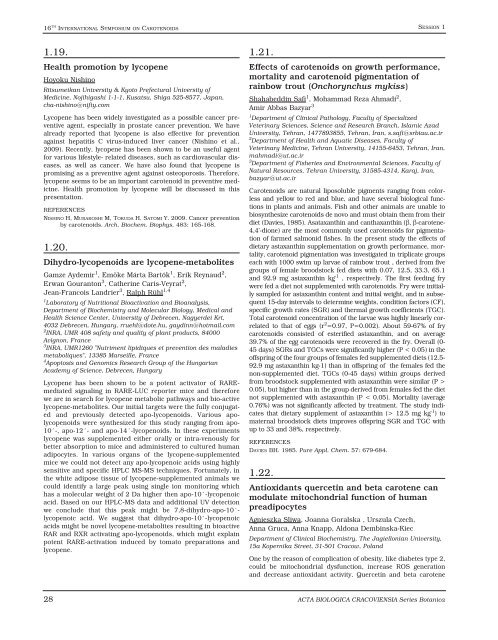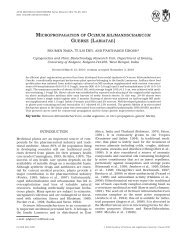ACTA BIOLOGICA CRACOVIENSIA
ACTA BIOLOGICA CRACOVIENSIA
ACTA BIOLOGICA CRACOVIENSIA
You also want an ePaper? Increase the reach of your titles
YUMPU automatically turns print PDFs into web optimized ePapers that Google loves.
16 TH INTERNATIONAL SYMPOSIUM ON CAROTENOIDS<br />
1.19.<br />
Health promotion by lycopene<br />
Hoyoku Nishino<br />
Ritsumeikan University & Kyoto Prefectural University of<br />
Medicine, Nojihigashi 1-1-1, Kusatsu, Shiga 525-8577, Japan,<br />
cha-nishino@nifty.com<br />
Lycopene has been widely investigated as a possible cancer preventive<br />
agent, especially in prostate cancer prevention. We have<br />
already reported that lycopene is also effective for prevention<br />
against hepatitis C virus-induced liver cancer (Nishino et al.,<br />
2009). Recently, lycopene has been shown to be an useful agent<br />
for various lifestyle- related diseases, such as cardiovascular diseases,<br />
as well as cancer. We have also found that lycopene is<br />
promising as a preventive agent against osteoporosis. Therefore,<br />
lycopene seems to be an important carotenoid in preventive medicine.<br />
Health promotion by lycopene will be discussed in this<br />
presentation.<br />
REFERENCES<br />
NISHINO H, MURAKOSHI M, TOKUDA H, SATOMI Y. 2009. Cancer prevention<br />
by carotenoids. Arch. Biochem. Biophys. 483: 165-168.<br />
1.20.<br />
Dihydro-lycopenoids are lycopene-metabolites<br />
Gamze Aydemir1 , Emöke Márta Bartók1 , Erik Reynaud2 ,<br />
Erwan Gouranton 3 , Catherine Caris-Veyrat2 ,<br />
Jean-Francois Landrier 3 , Ralph Rühl1,4 1Laboratory of Nutritional Bioactivation and Bioanalysis,<br />
Department of Biochemistry and Molecular Biology, Medical and<br />
Health Science Center, University of Debrecen, Nagyerdei Krt,<br />
4032 Debrecen, Hungary, rruehl@dote.hu, gaydinn@hotmail.com<br />
2INRA, UMR 408 safety and quality of plant products, 84000<br />
Avignon, France<br />
3INRA, UMR1260 "Nutriment lipidiques et prevention des maladies<br />
metaboliques", 13385 Marseille, France<br />
4Apoptosis and Genomics Research Group of the Hungarian<br />
Academy of Science, Debrecen, Hungary<br />
Lycopene has been shown to be a potent activator of RAREmediated<br />
signaling in RARE-LUC reporter mice and therefore<br />
we are in search for lycopene metabolic pathways and bio-active<br />
lycopene-metabolites. Our initial targets were the fully conjugated<br />
and previously detected apo-lycopenoids. Various apolycopenoids<br />
were synthesized for this study ranging from apo-<br />
10´-, apo-12´- and apo-14´-lycopenoids. In these experiments<br />
lycopene was supplemented either orally or intra-venously for<br />
better absorption to mice and administered to cultured human<br />
adipocytes. In various organs of the lycopene-supplemented<br />
mice we could not detect any apo-lycopenoic acids using highly<br />
sensitive and specific HPLC MS-MS techniques. Fortunately, in<br />
the white adipose tissue of lycopene-supplemented animals we<br />
could identify a large peak using single ion monitoring which<br />
has a molecular weight of 2 Da higher then apo-10´-lycopenoic<br />
acid. Based on our HPLC-MS data and additional UV detection<br />
we conclude that this peak might be 7,8-dihydro-apo-10´lycopenoic<br />
acid. We suggest that dihydro-apo-10´-lycopenoic<br />
acids might be novel lycopene-metabolites resulting in bioactive<br />
RAR and RXR activating apo-lycopenoids, which might explain<br />
potent RARE-activation induced by tomato preparations and<br />
lycopene.<br />
1.21.<br />
Effects of carotenoids on growth performance,<br />
mortality and carotenoid pigmentation of<br />
rainbow trout (Onchorynchus mykiss)<br />
Shahabeddin Safi1 , Mohammad Reza Ahmadi2 ,<br />
Amir Abbas Bazyar3 1Department of Clinical Pathology, Faculty of Specialized<br />
Veterinary Sciences, Science and Research Branch, Islamic Azad<br />
University, Tehran, 1477893855, Tehran, Iran, s.safi@srbiau.ac.ir<br />
2Department of Health and Aquatic Diseases, Faculty of<br />
Veterinary Medicine, Tehran University, 14155-6453, Tehran, Iran,<br />
mahmadi@ut.ac.ir<br />
3Department of Fisheries and Environmental Sciences, Faculty of<br />
Natural Resources, Tehran University, 31585-4314, Karaj, Iran,<br />
bazyar@ut.ac.ir<br />
Carotenoids are natural liposoluble pigments ranging from colorless<br />
and yellow to red and blue, and have several biological functions<br />
in plants and animals. Fish and other animals are unable to<br />
biosynthesize carotenoids de novo and must obtain them from their<br />
diet (Davies, 1985). Asataxanthin and canthaxanthin (β, β-carotene-<br />
4,4’-dione) are the most commonly used carotenoids for pigmentation<br />
of farmed salmonid fishes. In the present study the effects of<br />
dietary astaxanthin supplementation on growth performance, mortality,<br />
carotenoid pigmentation was investigated in triplicate groups<br />
each with 1000 swim up larvae of rainbow trout , derived from five<br />
groups of female broodstock fed diets with 0.07, 12.5, 33.3, 65.1<br />
and 92.9 mg astaxanthin kg -1 , respectively. The first feeding fry<br />
were fed a diet not supplemented with carotenoids. Fry were initially<br />
sampled for astaxanthin content and initial weight, and in subsequent<br />
15-day intervals to determine weights, condition factors (CF),<br />
specific growth rates (SGR) and thermal growth coefficients (TGC).<br />
Total carotenoid concentration of the larvae was highly linearly correlated<br />
to that of eggs (r 2 =0.97, P=0.002). About 59-67% of fry<br />
carotenoids consisted of esterified astaxanthin, and on average<br />
39.7% of the egg carotenoids were recovered in the fry. Overall (0-<br />
45 days) SGRs and TGCs were significantly higher (P < 0.05) in the<br />
offspring of the four groups of females fed supplemented diets (12.5-<br />
92.9 mg astaxanthin kg-1) than in offspring of the females fed the<br />
non-supplemented diet. TGCs (0-45 days) within groups derived<br />
from broodstock supplemented with astaxanthin were similar (P ><br />
0.05), but higher than in the group derived from females fed the diet<br />
not supplemented with astaxanthin (P < 0.05). Mortality (average<br />
0.76%) was not significantly affected by treatment. The study indicates<br />
that dietary supplement of astaxanthin (> 12.5 mg kg -1 ) to<br />
maternal broodstock diets improves offspring SGR and TGC with<br />
up to 33 and 38%, respectively.<br />
REFERENCES<br />
DAVIES BH. 1985. Pure Appl. Chem. 57: 679-684.<br />
1.22.<br />
SESSION 1<br />
Antioxidants quercetin and beta carotene can<br />
modulate mitochondrial function of human<br />
preadipocytes<br />
Agnieszka Sliwa, Joanna Goralska , Urszula Czech,<br />
Anna Gruca, Anna Knapp, Aldona Dembinska-Kiec<br />
Department of Clinical Biochemistry, The Jagiellonian University,<br />
15a Kopernika Street, 31-501 Cracow, Poland<br />
One by the reason of complication of obesity, like diabetes type 2,<br />
could be mitochondrial dysfunction, increase ROS generation<br />
and decrease antioxidant activity. Quercetin and beta carotene<br />
28 <strong>ACTA</strong> <strong>BIOLOGICA</strong> <strong>CRACOVIENSIA</strong> Series Botanica












